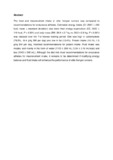| dc.contributor.author | Onywera, V.O. | |
| dc.contributor.author | Kiplamai, F.K. | |
| dc.contributor.author | Tuitoek, Prisca J. | |
| dc.contributor.author | Boit, M.K. | |
| dc.contributor.author | Pitsiladis, Y.P. | |
| dc.date.accessioned | 2017-08-31T11:48:16Z | |
| dc.date.available | 2017-08-31T11:48:16Z | |
| dc.date.issued | 2004-12 | |
| dc.identifier.citation | International Journal for Sports Nutrition and Exercise Metabolism, 2004, 14(6):709-719. | en_US |
| dc.identifier.uri | http://journals.humankinetics.com/doi/abs/10.1123/ijsnem.14.6.709?journalCode=ijsnem | |
| dc.identifier.uri | http://hdl.handle.net/123456789/2763 | |
| dc.identifier.uri | https://doi.org/10.1123/ijsnem.14.6.709 | |
| dc.description | https://doi.org/10.1123/ijsnem.14.6.709 | en_US |
| dc.description.abstract | The food and macronutrient intake of elite Kenyan runners was compared to recommendations for endurance athletes. Estimated energy intake (EI: 2987 ± 293 kcal; mean ± standard deviation) was lower than energy expenditure (EE: 3605 ± 119 kcal; P < 0.001) and body mass (BM: 58.9 ± 2.7 kg vs. 58.3 ± 2.6 kg; P < 0.001) was reduced over the 7-d intense training period. Diet was high in carbohydrate (76.5%, 10.4 g/kg BM per day) and low in fat (13.4%). Protein intake (10.1%; 1.3 g/kg BM per day) matched recommendations for protein intake. Fluid intake was modest and mainly in the form of water (1113 ± 269 mL; 0.34 ± 0.16 mL/kcal) and tea (1243 ± 348 mL). Although the diet met most recommendations for endurance athletes for macronutrient intake, it remains to be determined if modifying energy balance and fluid intake will enhance the performance of elite Kenyan runners. | en_US |
| dc.language.iso | en | en_US |
| dc.publisher | Human Kinetics Publishers | en_US |
| dc.subject | Kenya | en_US |
| dc.subject | endurance athletes | en_US |
| dc.subject | diet | en_US |
| dc.subject | training | en_US |
| dc.subject | high altitude | en_US |
| dc.title | Food and Macronutrient Intake of Elite Kenyan Distance Runners | en_US |
| dc.type | Article | en_US |

